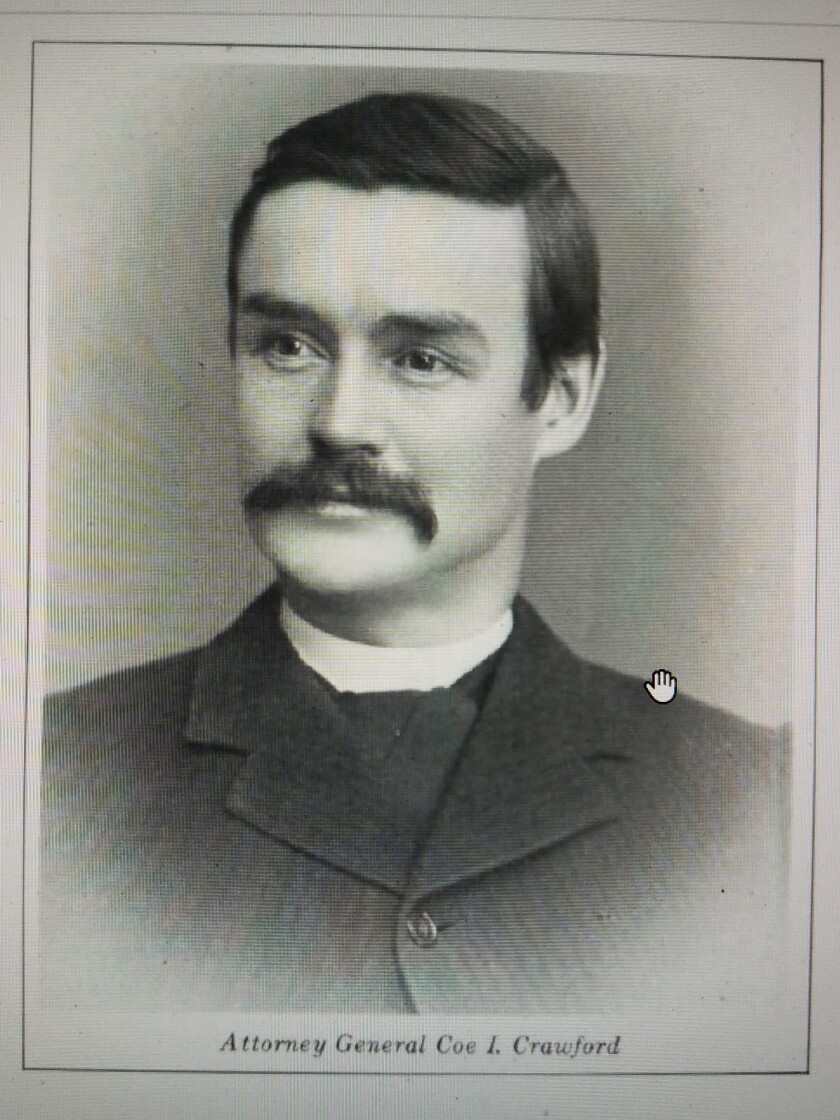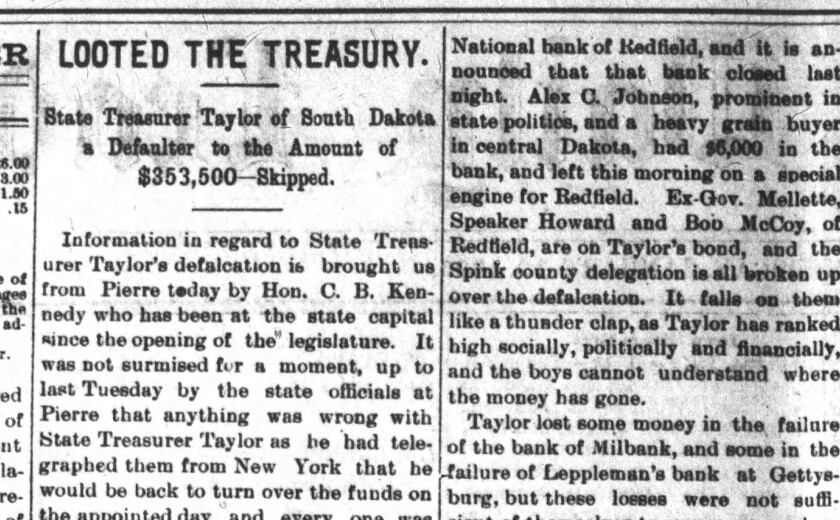South Dakota
The impact of ‘Wandering Willie,’ South Dakota state treasurer who stole entire state treasury in 1895

PIERRE — When South Dakota Gov. Charles H. Sheldon offered his opening message to the state legislature in January of 1895 in Pierre, he heaped praise on the outgoing state treasurer W.W. Taylor.
“Mr. W.W. Taylor, our efficient and faithful outgoing treasurer is entitled to the thanks of the people for the zeal and energy which he has at all times displayed in the management of his office,” Sheldon said. “And it is a matter of pride to him, as to the state officers with whom he has been associated for the past two years, that he leaves the public service carrying with him the unbounded respect of those who have known his business methods and his desire to preserve the credit of his state.”
The very next day, Sheldon asked for those words to be stricken from the official journal. And with good reason.
The day after Sheldon had given those remarks, Taylor, president of banks in Redfield and Gettysburg who had been elected to two terms as treasurer, had failed to appear in the capital to turn over the treasury to his successor and had, stunningly, absconded with practically all the funds that were under his supervision.
After some quick calculations, officials determined that Taylor had made off with about $367,020.59. That equates to roughly $13.3 million in 2023 currency.
So began a mad scramble to find Taylor, punish him for his deeds and recover as much of the money as possible as quickly as possible. It was a unique case both for the time and today, and also led to a series of regulation reforms when it came to proper handling of public money.
Image Courtesy of Newspapers.com
Even before finding Taylor, with the treasury now essentially empty, state officials needed to make sure South Dakota could meet its financial obligations. They performed a series of financial maneuvers that put the state on comparatively safe, if unstable, ground for the time being.
Ben Jones, state historian for South Dakota, said Taylor was likely trying to navigate a difficult financial times in the country, and loose state laws allowed him to.
“It’s not quite clear, but it appeared he was going to use the state’s money to pay off his debts,” Jones told the Mitchell Republic in a recent interview. “A lot of banks at the time were failing. We’ve gotten used to that since World War II – we expect an economic downturn every five to seven years. It’s not like it doesn’t happen today. But there are things in place to stop the hemorrhaging, and none of that was in place (in 1895).”

Image Courtesy South Dakota State Historical Society
With a relatively free hand to deposit and invest state money as he wished, Taylor exercised an immense amount of control on how state funds were handled.
As treasurer, he had broad the power to manipulate state funds, according to
“A State Treasurer Defaults: The Taylor Case of 1895 by C. Perry Armin,”
a reflective piece that appeared in a 1986 quarterly edition of the South Dakota Historical Society Journal.
State public examiners admitted that outside a series of deposits in a few banks in Pierre, they had mostly taken Taylor at his word about the amounts deposited in various institutions. In four years, they had only taken one look at the largest amounts, which happened to be deposited in Taylor’s home bank in Redfield. The deputy treasurer under Taylor, W.A. Burrington, reported that Taylor had made deposits and investments around the country, including in banks in Chicago.
Taylor’s attorney, Charles T. McCoy, testified that his client had lost hundreds of thousands of dollars through failed mortgage companies, real estate investments and a “Head Light Institution.”
State officials were desperate to find Taylor, bring him back to South Dakota and hand down punishment for his transgressions. The lingering question remained, however.
Where did Taylor go?
South Dakota Attorney General Coe I. Crawford petitioned the legislature to offer a reward of $2,000, a little under $73,000 today, for the apprehension of Taylor. The famous Pinkerton Detective Agency was brought in to help track the former treasurer down.
With automobiles still a novelty and no airplanes at the time, the world was a bigger place in 1895, but he managed to leave South Dakota and travel parts of the world when he made his escape. Soon, the Pinkertons were chasing down leads across the country, from Florida to California, and as far abroad as South America, where many countries lacked an extradition treaty with the United States.
Descriptions of Taylor, whose actual first name has been a matter of debate among historians – either William Walter or Walter William – were sent out to police departments around the country. He was listed as “about 5 feet 6 inches, heavy set, weight 190 to 200 pounds, sloping shoulders, light short mustache, ruddy complexion, blue eyes, rather large mouth with hanging under lip, slightly bald, hair tinged with gray, walks with a sort of waddling gait.”
The Pinkertons, despite their reputation for tenacity, were unable to immediately track him down, but eventually Taylor tired of life on the run. Rumors began to circulate that he would turn himself in and return to South Dakota to face the music. The state had paid an agent $800 to accompany Taylor from Chicago, where he had turned himself in, to Pierre in order to insure he would appear and that he would not be arrested by someone else hoping to simply cash in on the reward.
The Pierre Daily Capital newspaper dated June 12, 1895, summed up the search with a dash of humor.
“WHOOP! Wandering Willie Works Westward With Waddling Walk, Weary, Wrecked, We Will Wonder Where Wandering Willie Went,” the paper headlined a news item on the developments.
On June 21, Taylor surrendered to state authorities and was freed on $25,000 bond to appear before the regular term of the Hughes County circuit court at Pierre in August. He pleaded guilty to an indictment on the charge of embezzlement, and he was sentenced shortly after to a term of five years at hard labor in the state penitentiary.
However, through a series of legal machinations, that sentence was reduced to two years. This was another example of how ineffectively some laws of the day were written.
Armin, writing in the 1986 journal piece, noted: “In short, the law that was supposed to cover the embezzlement of public funds failed to mention the actual taking of government money.”

Image Courtesy of Newspapers.com
Taylor received four months off his sentence for good behavior, eventually serving 18 months in the state penitentiary.
The reduced sentence was controversial, with many members of the public and newspaper editors alike stating that Taylor had gotten off easy. The Sioux Falls Evening Argus-Leader was particularly pointed in its assessment.
“(The court’s decision is) the blackest day which South Dakota has known since her entrance into the Union … The whole world has watched this matter. It has noted that men who stole a few dollars worth of bread or money have been sent to the penitentiary for years, but that the rich, influential, popular and politically powerful thief who steals a quarter of a million gets a punishment of only a year and a half,” the paper wrote, adding that it would have been better to let Taylor escape entirely rather than the state hand down as soft a sentence as it did.
Jones said the light sentence is part of what set the wheels in motion for stronger regulatory laws governing public money. It raised the flag that it was time for South Dakota to move away from the territorial laws that still influenced state regulations and to come up with a modern code of conduct.
“People of South Dakota aren’t going to let that continue. I think a lot of them said if you make off with six figures of public funds, you need to do some time,” Jones said. “It’s not something you should be able to make a plea and walk.”

Image Courtesy of Newspapers.com
The fallout of the incident went on for years, and involved securing assets and property from Taylor, as well as several individuals and bondsmen who were suspected of being accomplices in some form, including some of his lawyers and his father.
The real estate acquired by the state from Taylor and his bondsmen remained on the state books and part of the subsequent treasurer’s annual reports, earning money through sale or lease, for nearly another 100 years, until 1983.
The state legislature subsequently made changes that required the treasurer to more closely record their work and to make it more easily open to inspection. Banks were also required to file an additional, similar report to the governor in regard to state funds.
Another provision was to require the state treasurer to show all state funds in cash. Through that rule, in January of 1897, the citizens of South Dakota were treated to the sight of nearly $300,000 in state funds being brought from banks in Chicago and South Dakota to Pierre under the protection of armed bank messengers and a company from the National Guard for the purpose of being hand-counted.
Further drama ensued when a train carrying the funds became stuck in the snow near Highmore, where “neither rescuers nor would-be robbers could reach it.” The event was not repeated out of concerns of practicality.
“The level of detail they employ after (Taylor) is quite astonishing. They make them truck it to Pierre. And this is an age before computations. It’s very physical, whereas today it’s all digital. That was quite the task for people to load it up in the middle of winter with all the security. The National Guard and police accompany it,” Jones said.

Image Courtesy South Dakota State Historical Society
Taylor himself moved to Chicago following his prison term, though his story is cloudy following his time in South Dakota. He reportedly worked as a secretary for the Cycle Skate Company of Chicago, and also worked as a clerk before moving to Glenwood, Illinois, where he died on Dec. 21, 1916. The cause of death was suspected to be alcoholism, a condition that could have fed his money management problems as a South Dakota state official.
But his legacy remains, partially as a reminder of the dangers of poor regulation and partly for his actions’ impact on statewide politics. The Republican party took a temporary hit in popularity, and Populists and Democrats were able to take control of the state legislature. Andrew E. Lee, a member of the Populist Party and the third governor of South Dakota and successor to Sheldon, became the first non-Republican governor of the state in 1897, although Republicans would regain the governorship again from the end of Lee’s term in 1901 until the election of Gov. William J. Bulow, a Democrat, in 1933.
Jones said he was unaware of any other cases that would directly parallel the Taylor case, either in terms of era or impact. But his actions made waves at the turn of the 20th century and left its mark on the state for almost a century after.
The entire incident was a wake-up call for South Dakota to grow up and to face the reality that it needed safeguards against corruption, no matter how trustworthy a public official may seem.
“The response to him sprouted or furthered a political movement that was already happening, and made it more personal for South Dakota,” Jones said. “But human failing is not legislated out of existence. We still expect people will be corrupt or incompetent and have a distant relationship with the truth, so it is proper and appropriate for government and public companies to put in safeguards to defend themselves.”

South Dakota
State Sen. Anthony Kern making his way back to Phoenix after icy crash in South Dakota

5 safety tips for winter driving conditions in Arizona
Taking a trip up to Flagstaff or driving through Prescott during the Arizona winter? Here are five tips to stay safe when cruising on winter roads.
The Republic
State Sen. Anthony Kern, R-Glendale, announced on the social media platform X on Sunday that he had left the hospital, about a week after breaking bones and suffering other injuries in a single-car crash in South Dakota.
Kern, who was visiting family, was riding with a friend through a snowstorm when the car hit ice and the driver lost control.
He posted that he was out of the critical stage and making his way back to Phoenix, but he couldn’t fly due to a collapsed lung.
Kern is finishing his first state Senate term after three terms in the state House. This fall, he opted to run for a congressional seat rather than seek a return to the state Capitol but lost the GOP race for Congressional District 8 to Abe Hamadeh.
South Dakota
South Dakota comedy performer dies

South Dakota
Sunday will be warm and breezy

RAPID CITY, S.D. (KOTA) – Partly cloudy skies are expected. A stray shower or two will be possible, but chances aren’t great. Highs will be in the 40s and 50s for much of KOTA Territory.
Wind gusts could range from 30 to 40 mph at times – especially across western South Dakota.
We’ll remain mild all Christmas week with highs in the 40s to near 50°. Mostly sunny to partly cloudy skies will be likely all week long. It could get a little breezy on Christmas Day, but nothing too crazy.
See a spelling or grammatical error in our story? Please click here to report it.
Do you have a photo or video of a breaking news story? Send it to us here with a brief description.
Copyright 2024 KOTA. All rights reserved.
-

 Politics1 week ago
Politics1 week agoCanadian premier threatens to cut off energy imports to US if Trump imposes tariff on country
-
/cdn.vox-cdn.com/uploads/chorus_asset/file/25789444/1258459915.jpg)
/cdn.vox-cdn.com/uploads/chorus_asset/file/25789444/1258459915.jpg) Technology1 week ago
Technology1 week agoOpenAI cofounder Ilya Sutskever says the way AI is built is about to change
-

 Politics1 week ago
Politics1 week agoU.S. Supreme Court will decide if oil industry may sue to block California's zero-emissions goal
-
/cdn.vox-cdn.com/uploads/chorus_asset/file/25546252/STK169_Mark_Zuckerburg_CVIRGINIA_D.jpg)
/cdn.vox-cdn.com/uploads/chorus_asset/file/25546252/STK169_Mark_Zuckerburg_CVIRGINIA_D.jpg) Technology1 week ago
Technology1 week agoMeta asks the US government to block OpenAI’s switch to a for-profit
-

 Business1 week ago
Business1 week agoFreddie Freeman's World Series walk-off grand slam baseball sells at auction for $1.56 million
-
/cdn.vox-cdn.com/uploads/chorus_asset/file/23951353/STK043_VRG_Illo_N_Barclay_3_Meta.jpg)
/cdn.vox-cdn.com/uploads/chorus_asset/file/23951353/STK043_VRG_Illo_N_Barclay_3_Meta.jpg) Technology1 week ago
Technology1 week agoMeta’s Instagram boss: who posted something matters more in the AI age
-
News1 week ago
East’s wintry mix could make travel dicey. And yes, that was a tornado in Calif.
-
/cdn.vox-cdn.com/uploads/chorus_asset/file/24924653/236780_Google_AntiTrust_Trial_Custom_Art_CVirginia__0003_1.png)
/cdn.vox-cdn.com/uploads/chorus_asset/file/24924653/236780_Google_AntiTrust_Trial_Custom_Art_CVirginia__0003_1.png) Technology2 days ago
Technology2 days agoGoogle’s counteroffer to the government trying to break it up is unbundling Android apps

















